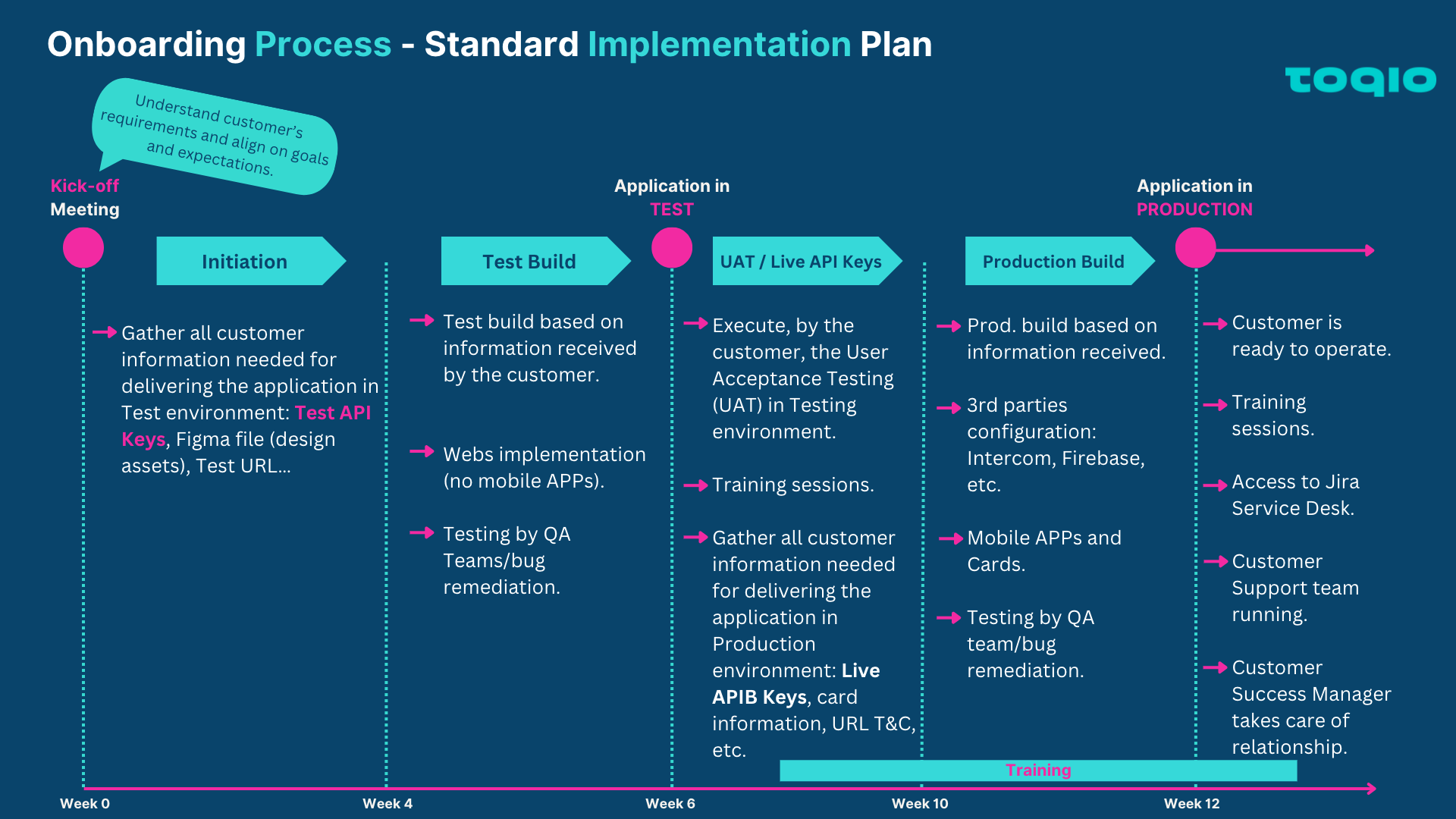Before you start
Before we start we will tell you what the onboarding process consists of, welcome aboard!
Onboarding Overview
From now on you have Toqio onboarding guides at your disposal that will provide you with all the support documentation you need to get your solution set up.
Throughout the initial onboarding process, you will be in contact with our Customer Success and Customer Onboarding teams, you can depend on them for everything you need.

We manage the onboarding process using our Platform Configuration Tools, which allow us to design and manage efficiently the end-to-end setup of our customers' solutions.
Platform Configuration: The configuration of your platform including all variables related to technical setup, hosting, 3rd-party integration, banking setup, and design are all managed via one single repository.
Go-Live Plan: Based on contractual agreements and the alignment of 3rd-party partners (e.g., banking), a week-by-week plan is created and tracked throughout the platform setup period.
Project Tracker: All custom requirements, issues, and requests are centrally managed and addressed weekly.

Our Customer Success Team will share with you the TOQIO design requirement documents that provide you with the detailed brand assets required to build your applications.
Although not exhaustive, the design assets required include your brand logos, imagery, fonts, icons, etc.
Platform Configuration
The TOQIO platform has extensive configuration options that allow customers to create a unique offering for their clients. As part of the onboarding process, all configuration variables are set as input for the application build process.
Platform Setup: The platform setup allows customers to define the URLs and emails that are used for the application, as well as setting the country(s) of regulation, among other variables.
Proposition Configuration: The proposition configuration allows customers to define their proposition type (e.g., Consumer, Business, or both), which products they will make available (e.g., FX, Cards, etc.), as well as several other enabling capabilities on their application.
Mobile Developer Account Access: Details related to providing TOQIO access to mobile developer accounts (e.g., Apple, Android) to publish mobile applications.
Banking Partner Configuration: Several key variables are defined via the banking partner configuration, including account types, currencies, payment types, and card program details.
Third-Party Integration: Integration details for key third-party integrations such as Firebase, Intercom, and TruNarrative are all set here.
Policies and Terms: The variables for the Software End User License Agreement are defined here; this is also where you set the links for the customer's banking, credit card terms, and privacy policy.

Technical Setup - Web Application setup
As part of the Web Application setup, the Customer must create a CNAME (or Sub-Domain) where End Users can access the online services. This Sub-Domain will point to the branded TOQIO platform, which is hosted on AWS. At all times, when End Users are using the Web Application, they will only see the customer domains.
CNAME Setup

To configure your website, we first need to create the SSL certificates for the Test and Production domains you have chosen:
- For the TEST environment, it should be test.cname.domain.com.
- For the LIVE environment, it should be cname.domain.com.
For this, you will need to create a CNAME record in your DNS provider (GoDaddy, DNS Made Easy, AWS Route 53, etc.) for verification of the SSL certificates with the configuration that we will send to you once the certificates are requested.

Once you create the CNAME for the SSL certificates (explained in the First Step), our team will create the CDN for your websites (test and live environments). The CDN is created with a domain like debl8olx1mpfp.cloudfront.net. Our Application Build Team then generates an email to you from AWS, which provides you with the CDN details.

The CNAME must be created within 72 hours of the request. Otherwise, AWS changes the certificate status to Validation timed out, and we have to request it again.
Design Assets - Platform Design
The TOQIO platform's extensive customization options allow customers to create unique branding and design across their online and mobile applications. As part of onboarding, all custom design assets are collected for the application build process.
Key Design Areas: The customizable design assets are listed in the TOQIO customization guide that customers receive as part of the onboarding process. This is a summary of the key design asset types:
- Primary Assets: These include app icons, brand logos, and background design images, all of which are required to set up your applications.
- Colours: A range of colour variables can be set in the application, including brand colours, font colours, background colours, and system colours (e.g., error notifications).
If you want further customization: - Fonts: The application fonts can be customized across the web and mobile devices.
- Icons: Icons are used throughout the applications and you can provide your own.
- Placeholder Images: Placeholders Images are used throughout the application. These include branded imagery to be shown as part of the onboarding process and holding imagery where no content yet exists, such as a list of cards when there are no cards.
Supporting Document: As part of the design process, customers receive detailed guidelines on using the full list of customizable assets as well as details required by designers.
*TOQIO Customization Guide: A detailed list of customizable assets, design examples and specifications of the platform that can be customized whether you require Business or Consumer Portal.
Third-Party Application
As part of the TOQIO platform setup, there are several required and optional 3rd party integrations that you'll need to set up. In this section, we provide detailed guides for each 3rd party item.
- Firebase: Used for mobile application notifications. Not required for customers who don't use mobile applications.
- Intercom: Used for chat and support integration. This feature set is required for TOQIO.
- TruNarrative: Used for compliance integration and required for Customers using the TOQIO digital onboarding.
Updated 7 months ago
